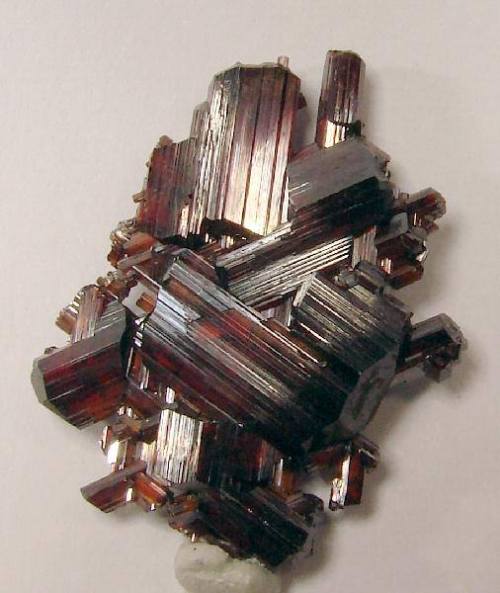
Ruddy rutile
The most common form of titanium dioxide was named after the Latin for red, due to the lovely deep hues exhibited by some specimens. It forms in both volcanic rocks and high temperature/high pressure metamorphic rocks, testament to the extreme conditions needed to distil it out of the Earth. It is also the most stable polymorph of TiO2. It is a common accessory mineral in plutonic rocks, magmas that never made it to the surface and cooled slowly in the crust when they reached their natural buoyancy point, though it sometimes occurs in lavas sourced deep in the mantle such as the (sometimes) diamond bearing kimberlites and lamproites. Some rutile is also formed by alteration of volcanic rocks.
Rutile has one of the highest reflectivities of any mineral, with an adamantine lustre (from the ancient Greek word for diamond), caused by its high refractive index (a measure of the degree to which the light slows bends on entering a different optical medium, visible every time you put your hand in water). It also exhibits high birefringence (the ability of minerals in some crystal systems to split the entering light into several rays that take different paths through the crystal structure, thus polarising them) and dispersion (seen in the flashing colour specks in a diamond, caused by the high refractive index, whereby the wavelengths of different energies are bent differently, as in the lead glass prisms Newton used to elucidate the nature of light). Common colours include red, brownish yellow, brown-red, yellow, black, brown, bluish or violet
It is also a common inclusion in many minerals, we are all familiar with rutilated quartz, but it is also often found in garnets and corundums (known as silk in the gem trade). Gemmologists use its patterns sometimes to distinguish localities of origin, for example long thin needles are common in Ceylon stones, while nests of short stubby needles distinguish the Mogok deposits of Burma.
They also form the stars in rubies and sapphires or catseye gems, exsolving as the gem crystallises into a pattern of three intersecting axes following the laws of crystallography. The light reflected off the needles then forms the star (see https://www.facebook.com/TheEarthStory/posts/569757233085325). As the crystals cool, the mixture of silica and rutile separate to form rutilated quartz, or the inclusions in other gems that produce these lovely optical effects.
Many corundums are routinely heat treated in an oven, one of the main purposes being transforming the rutile, either by dissolving it to improve the transparency of a crystal or in order to release the titanium to impart a deep blue colour to a whitish or yellowish cloudy rough crystal. The phantom needles are often visible as dotted points with blobs of colour around them, allowing us to determine that the stone has been treated. Igneous and metamorphic petrologists can also use its trace element geochemistry to learn something of the pressure and temperature conditions that attended its formation, garnets often being used as geothermometer and geobarometer minerals.
Specimens like this originate in granitic pegmatites, the late phases of the crystallisation process where slow cooling allows larger crystals to grow. Other sources include skarns, the baked areas around granites that intrude limestone due to contact metamorphism.
It has many uses, including refractory ceramics (eg for ovens etc), as a white pigment in paints, sunscreens, optics (such as infra red polarising elements) and the production of pure titanium for industrial and jewellery uses (such as high tech alloys because of its light weight, high strength and resistance to corrosion). Most industrial rutile comes from Sierra Leone, though in some places beach sands where heavy minerals have been concentrated by wind and wave are also exploited. Synthetic rutile has also been used as a diamond imitant, due to its similar properties, but a swift hardness test will reveal its nature since rutile is only 6 on Mohs scale.
This intergrown striated specimen comes from the Diamantina region of Minas Gerais in Brazil, measuring 2.5 x 2 x .3 cm.
Loz
Image credit: Rob Lavinsky/iRocks.com
http://www.galleries.com/Rutile
http://webmineral.com/data/Rutile.shtml#.VGUb8slQBZ4
http://www.mindat.org/min-3486.html






